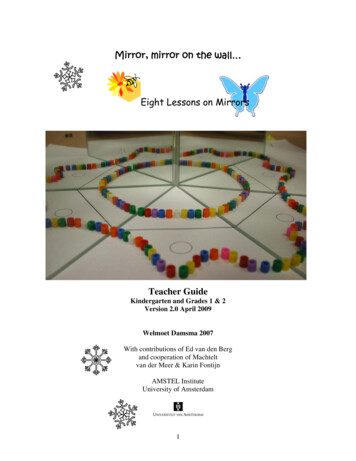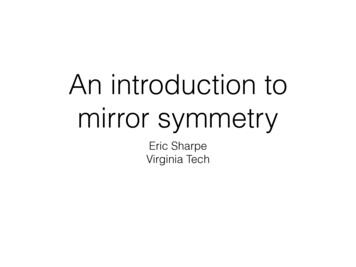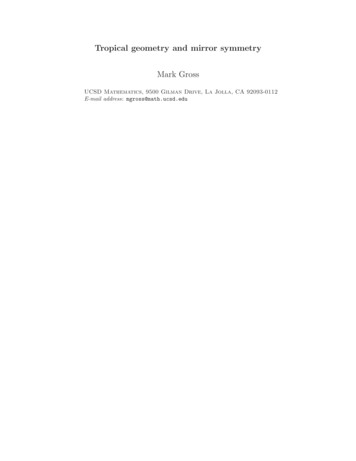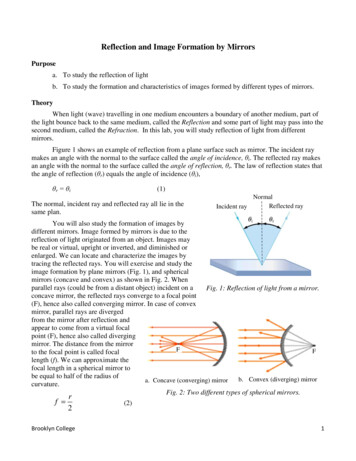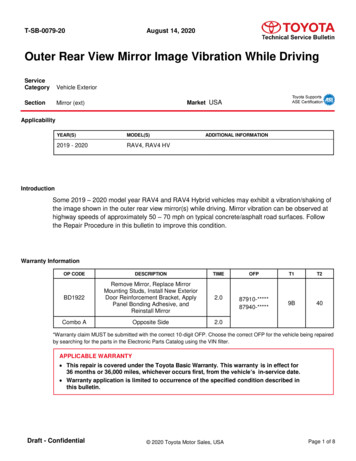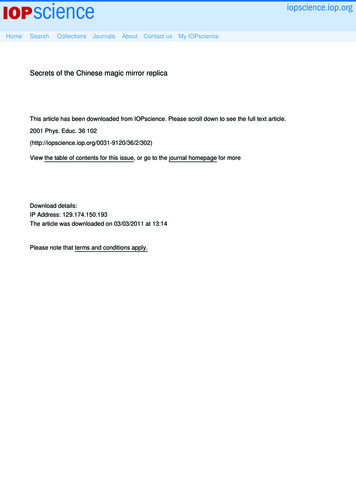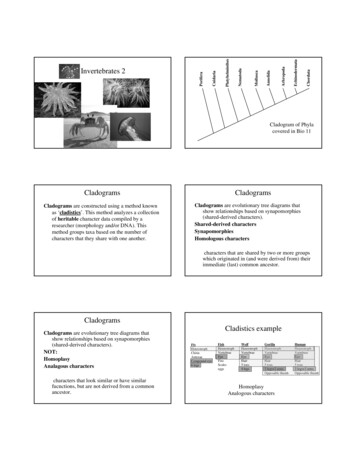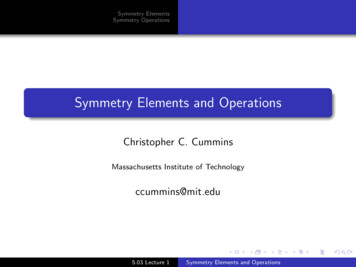
Transcription
1This book grew out of an intense, month-long course on mirror symmetry at PineManor College, sponsored by the Clay Mathematics Institute. The lecturers havetried to summarize this course in a coherent, unified text.For additional informationand updates on this book, visitwww.ams.org/bookpages/cmim-1Cumrun Vafa and Eric Zaslow, EditorsThis book aims to give a single, cohesive treatment of mirror symmetry fromboth the mathematical and physical viewpoint. Parts 1 and 2 develop the necessary mathematical and physical background “from scratch,” and are intended forreaders trying to learn across disciplines. The treatment is focussed, developingonly the material most necessary for the task. In Parts 3 and 4 the physical andmathematical proofs of mirror symmetry are given. From the physics side, thismeans demonstrating that two different physical theories give isomorphicphysics. Each physical theory can be described geometrically, and thus mirrorsymmetry gives rise to a “pairing” of geometries. The proof involves applyingR 1/R circle duality to the phases of the fields in the gauged linear sigmamodel. The mathematics proof develops Gromov-Witten theory in the algebraicsetting, beginning with the moduli spaces of curves and maps, and uses localization techniques to show that certain hypergeometric functions encode theGromov-Witten invariants in genus zero, as is predicted by mirror symmetry. Part5 is devoted to advanced topics in mirror symmetry, including the role ofD-branes in the context of mirror symmetry, and some of their applications inphysics and mathematics: topological strings and large N Chern-Simons theory;geometric engineering; mirror symmetry at higher genus; Gopakumar-Vafainvariants; and Kontsevich’s formulation of the mirror phenomenon as an equivalence of categories.Mirror SymmetryMirror symmetry is a phenomenon arising in string theory in which two verydifferent manifolds give rise to equivalent physics. Such a correspondence hassignificant mathematical consequences, the most familiar of which involves theenumeration of holomorphic curves inside complex manifolds by solving differential equations obtained from a “mirror” geometry. The inclusion of D-branestates in the equivalence has led to further conjectures involving calibratedsubmanifolds of the mirror pairs and new (conjectural) invariants of complexmanifolds: the Gopakumar Vafa invariants.www.ams.or gCMIM/1www.claymath.or g3 color cover: This plate PMS 123 Yellow; This plate PMS 187 Red; This plate Black InkAMSCMIClay Mathematics MonographsVolume 1MIRROR SYMMETRYKentaro HoriSheldon KatzAlbrecht KlemmRahul PandharipandeRichard ThomasCumrun VafaRavi VakilEric ZaslowAmerican Mathematical SocietyClay Mathematics Institute952 pages pages on 50 lb stock 2 5/8 spine
cmim-1-title.qxp6/11/0311:03 AMPage 2MIRROR SYMMETRY
cmim-1-title.qxp6/11/0311:01 AMPage 1Clay Mathematics MonographsVolume 1MIRROR SYMMETRYKentaro HoriSheldon KatzAlbrecht KlemmRahul PandharipandeRichard ThomasCumrun VafaRavi VakilEric ZaslowAmerican Mathematical SocietyClay Mathematics Institute
2000 Mathematics Subject Classification. Primary 14J32; Secondary 14-02, 14N10,14N35, 32G81, 32J81, 32Q25, 81T30.For additional information and updates on this book, visitwww.ams.org/bookpages/cmim-1Library of Congress Cataloging-in-Publication DataMirror symmetry / Kentaro Hori . [et al.].p. cm. — (Clay mathematics monographs, ISSN 1539-6061 ; v. 1)Includes bibliographical references and index.ISBN 0-8218-2955-6 (alk. paper)1. Mirror symmetry. 2. Calabi-Yau manifolds. 3. Geometry, Enumerative.II. Series.QC174.17.S9M5617530.14 3–dc21I. Hori, Kentaro.20032003052414Copying and reprinting. Individual readers of this publication, and nonprofit librariesacting for them, are permitted to make fair use of the material, such as to copy a chapter for usein teaching or research. Permission is granted to quote brief passages from this publication inreviews, provided the customary acknowledgment of the source is given.Republication, systematic copying, or multiple reproduction of any material in this publicationis permitted only under license from the Clay Mathematics Institute. Requests for such permissionshould be addressed to the Clay Mathematics Institute, 1770 Massachusetts Ave., #331, Cambridge, MA 02140, USA. Requests can also be made by e-mail to permissions@claymath.org.c 2003 by the authors. All rights reserved. Published by the American Mathematical Society, Providence, RI,for the Clay Mathematics Institute, Cambridge, MA.Printed in the United States of America. The paper used in this book is acid-free and falls within the guidelines established to ensure permanence and durability.Visit the AMS home page at http://www.ams.org/Visit the Clay Mathematics Institute home page at http://www.claymath.org/10 9 8 7 6 5 4 3 2 108 07 06 05 04 03
ContentsPrefacexiIntroductionA History of Mirror SymmetryThe Organization of this BookPart 1.xiiixvxviiMathematical Preliminaries1Chapter 1. Differential Geometry1.1. Introduction1.2. Manifolds1.3. Vector Bundles1.4. Metrics, Connections, Curvature1.5. Differential Forms33451118Chapter 2. Algebraic Geometry2.1. Introduction2.2. Projective Spaces2.3. Sheaves2.4. Divisors and Line Bundles2525253238Chapter 3. Differential and Algebraic Topology3.1. Introduction3.2. Cohomology Theories3.3. Poincaré Duality and Intersections3.4. Morse Theory3.5. Characteristic Classes3.6. Some Practice Calculations41414142434553Chapter 4. Equivariant Cohomology and Fixed-Point Theorems4.1. A Brief Discussion of Fixed-Point Formulas5757v
viCONTENTS4.2. Classifying Spaces, Group Cohomology, andEquivariant Cohomology4.3. The Atiyah–Bott Localization Formula4.4. Main Example586264Chapter 5. Complex and Kähler Geometry5.1. Introduction5.2. Complex Structure5.3. Kähler Metrics5.4. The Calabi–Yau Condition6767677174Chapter 6. Calabi–Yau Manifolds and Their Moduli6.1. Introduction6.2. Deformations of Complex Structure6.3. Calabi–Yau Moduli Space6.4. A Note on Rings and Frobenius Manifolds6.5. Main Example: Mirror Symmetry for the Quintic6.6. Singularities77777982878895Chapter 7. Toric Geometry for String Theory7.1. Introduction7.2. Fans7.3. GLSM7.4. Intersection Numbers and Charges7.5. Orbifolds7.6. Blow-Up7.7. Morphisms7.8. Geometric Engineering7.9. Polytopes7.10. Mirror Symmetry101101102111114121123126130132137Part 2.143Physics PreliminariesChapter 8. What Is a QFT?8.1. Choice of a Manifold M8.2. Choice of Objects on M and the Action S8.3. Operator Formalism and Manifolds with Boundaries8.4. Importance of Dimensionality145145146146147
CONTENTSviiChapter 9. QFT in d 09.1. Multivariable Case9.2. Fermions and Supersymmetry9.3. Localization and Supersymmetry9.4. Deformation Invariance9.5. Explicit Evaluation of the Partition Function9.6. Zero-Dimensional Landau–Ginzburg 0.4.10.5.10. QFT in Dimension 1: Quantum MechanicsQuantum MechanicsThe Structure of Supersymmetric Quantum MechanicsPerturbative Analysis: First ApproachSigma .11.3.11.4.11. Free Quantum Field Theories in 1 1 DimensionsFree Bosonic Scalar Field TheorySigma Model on Torus and T-dualityFree Dirac 3.12.4.12.5.12. N (2, 2) SupersymmetrySuperfield FormalismBasic ExamplesN (2, 2) Supersymmetric Quantum Field TheoriesThe Statement of Mirror .13.3.13.4.13. Non-linear Sigma Models and Landau–Ginzburg ModelsThe ModelsR-SymmetriesSupersymmetric Ground StatesSupersymmetric Sigma Model on T 2 and Mirror Symmetry291291294299307Chapter 14. Renormalization Group Flow14.1. Scales14.2. Renormalization of the Kähler Metric313313315
viiiCONTENTS14.3. Superspace Decouplings and Non-Renormalization ofSuperpotential14.4. Infrared Fixed Points and Conformal Field Theories331335Chapter15.1.15.2.15.3.15.4.15.5.15. Linear Sigma ModelsThe Basic IdeaSupersymmetric Gauge TheoriesRenormalization and Axial AnomalyNon-Linear Sigma Models from Gauge TheoriesLow Energy .4.16. Chiral Rings and Topological Field TheoryChiral RingsTwistingTopological Correlation Functions and Chiral RingsExamples397397399404408Chapter 17. Chiral Rings and the Geometry of the Vacuum Bundle17.1. tt Equations423423Chapter18.1.18.2.18.3.18.4.18.5.18. BPS Solitons in N 2 Landau–Ginzburg TheoriesVanishing CyclesPicard–Lefschetz MonodromyNon-compact n-CyclesExamplesRelation Between tt Geometry and BPS . D-branesWhat are D-branes?Connections Supported on D-branesD-branes, States and Periods449449452454Part 3.Chapter20.1.20.2.20.3.20.4.Mirror Symmetry: Physics Proof20. Proof of Mirror SymmetryWhat is Meant by the Proof of Mirror SymmetryOutline of the ProofStep 1: T-Duality on a Charged FieldStep 2: The Mirror for Toric Varieties461463463464465472
CONTENTS20.5. Step 3: The Hypersurface CasePart 4.Mirror Symmetry: Mathematics Proofix474481Chapter 21. Introduction and Overview21.1. Notation and Conventions483483Chapter22.1.22.2.22.3.22. Complex Curves (Non-singular and Nodal)From Topological Surfaces to Riemann SurfacesNodal CurvesDifferentials on Nodal Curves487487489491Chapter23.1.23.2.23.3.23.4.23. Moduli Spaces of CurvesMotivation: Projective Space as a Moduli SpaceThe Moduli Space Mg of Non-singular Riemann SurfacesThe Deligne–Mumford Compactification Mg of MgThe Moduli Spaces Mg,n of Stable Pointed . Moduli Spaces Mg,n (X, β) of Stable MapsExample: The GrassmannianExample: The Complete (plane) ConicsSeven Properties of Mg,n (X, β)Automorphisms, Deformations, 5.4.25. Cohomology Classes on Mg,n and Mg,n (X, β)Classes Pulled Back from XThe Tautological Line Bundles Li , and the Classes ψiThe Hodge Bundle E, and the Classes λkOther Classes Pulled Back from Mg,n509509512516517Chapter 26. The Virtual Fundamental Class, Gromov–WittenInvariants, and Descendant Invariants26.1. The Virtual Fundamental Class26.2. Gromov–Witten Invariants and Descendant Invariants26.3. String, Dilaton, and Divisor Equations for Mg,n (X, β)26.4. Descendant Invariants from Gromov–Witten Invariants inGenus 026.5. The Quantum Cohomology Ring528530Chapter 27. Localization on the Moduli Space of Maps535519519526527
xCONTENTS27.1.27.2.27.3.27.4.27.5.27.6.27.7.The Equivariant Cohomology of Projective SpaceExample: Branched Covers of P1Determination of Fixed LociThe Normal Bundle to a Fixed LocusThe Aspinwall–Morrison FormulaVirtual LocalizationThe Full Multiple Cover Formula for P1535538540542546548551Chapter 28. The Fundamental Solution of the Quantum DifferentialEquation55328.1. The “Small” Quantum Differential Equation55528.2. Example: Projective Space Revisited556Chapter 29. The Mirror Conjecture for Hypersurfaces I: The FanoCase29.1. Overview of the Conjecture29.2. The Correlators S(t, ) and SX (t, )29.3. The Torus Action29.4. LocalizationChapter 30.30.1.30.2.30.3.30.4.Part 5.The Mirror Conjecture for Hypersurfaces II: TheCalabi–Yau CaseCorrelator RecursionsPolynomialityCorrelators of Class PTransformations559559562565565Advanced TopicsChapter 31. Topological Strings31.1. Quantum Field Theory of Topological Strings31.2. Holomorphic 8358558559332. Topological Strings and Target Space Physics599Aspects of Target Space Physics599Target Space Interpretation of Topological String Amplitudes 601Counting of D-branes and Topological String Amplitudes606Black Hole Interpretation612
CONTENTSxiChapter 33. Mathematical Formulation of Gopakumar–Vafa Invariants 615Chapter 34. Multiple Covers, Integrality, and Gopakumar–VafaInvariants34.1. The Gromov–Witten Theory of Threefolds34.2. Proposal34.3. Consequences for Algebraic Surfaces34.4. Elliptic Rational Surfaces34.5. OutlookChapter35.1.35.2.35.3.35.4.35.5.35.6.35. Mirror Symmetry at Higher GenusGeneral Properties of the Genus 1 Topological AmplitudeThe Topological Amplitude F1 on the TorusThe Ray-Singer Torsion and the Holomorphic AnomalyThe Annulus Amplitude Fann of the Open Topological StringF1 on Calabi–Yau in Three Complex DimensionsIntegration of the Higher Genus Holomorphic AnomalyEquations35.7. Appendix A: Poisson 675Chapter 36. Some Applications of Mirror Symmetry36.1. Geometric Engineering of Gauge Theories36.2. Topological Strings And Large N Chern–Simons Theory677677680Chapter 37. Aspects of Mirror Symmetry and D-branes37.1. Introduction37.2. D-branes and Mirror Symmetry37.3. D-branes in IIA and IIB String Theory37.4. Mirror Symmetry as Generalized T-Duality37.5. Mirror Symmetry with Bundles37.6. Mathematical Characterization of D-branes37.7. Kontsevich’s Conjecture37.8. The Elliptic Curve37.9. A Geometric Functor37.10. The Correspondence Principle691691692695698704707709714720724Chapter 38. More on the Mathematics of D-branes: Bundles, DerivedCategories, and Lagrangians729
c Bundles and Gauge TheoryDerived categoriesLagrangians72973173874439. Boundary N 2 TheoriesOpen Strings — Free TheoriesSupersymmetric Boundary Conditions in N 2 TheoriesR-AnomalySupersymmetric Ground StatesBoundary States and Overlap with RR Ground StatesD-Brane Charge and MonodromyD-Branes in N 2 Minimal ModelsMirror Symmetry765766793809819847859870884Chapter 40. References889Bibliography905Index921
PrefaceIn the spring of 2000, the Clay Mathematics Institute (CMI) organizeda school on Mirror Symmetry, held at Pine Manor College, Brookline, Massachusetts. The school was intensive, running for four weeks and includingabout 60 graduate students, selected from nominations by their advisors,and roughly equally divided between physics and mathematics. The lecturers were chosen based on their expertise in the subject as well as theirability to communicate with students. There were usually three lectures every weekday, with weekends reserved for excursions and relaxation, as well astime to catch up with a rapidly developing curriculum. The first two weeksof the school covered preliminary physics and mathematics. The third weekwas devoted to the proof of mirror symmetry. The last week introducedmore advanced topics.This book is a product of that month-long school. Notes were takenfor some of the lectures by Amer Iqbal, Amalavoyal Chari and Chiu-ChuMelissa Liu and put into a rough draft. Other parts were added by thelecturers themselves. Part 1 of the book is the work of Eric Zaslow (withthe contribution of Ch. 7 by Sheldon Katz). Part 2 was based on thelectures of Kentaro Hori and myself (most of it is Hori’s). Part 3 was basedon my own lectures. Part 4 is the work of Rahul Pandharipande and RaviVakil, based on lectures by Rahul Pandharipande. Part 5 involves variouscontributions by different authors. Chs. 31, 32 and 36 were based on mylectures. Ch. 33 was written by Sheldon Katz. Ch. 34 was written by RahulPandharipande and Ravi Vakil, based on lectures by Rahul Pandharipande.Ch. 35 was written by Albrecht Klemm. Ch. 37 was written by Eric Zaslow.Ch. 38 is based on the lectures by Richard Thomas. Finally Ch. 39 waswritten by Kentaro Hori.Given that the authors were writing in different locations, and in theinterest of a more convenient mechanism of communication among variousauthors, CMI set up an internet-accessible system where various authorsxiii
xivPREFACEcould see what each one was writing and mutually correlate their contributions. The set-up was developed by Gordon Ritter and prove to be crucialfor the completion of the book. Vida Salahi was the manager of the corresponding site and set the relevant deadlines for completion and delivery.She continued to provide tremendous assistance with manuscript preparation during the months following the school.We have also had a gratifying abundance of secretarial assistance. Inparticular, Dayle Maynard and John Barrett ran the daily activities of theschool, registering the incoming students, producing copies of lectures for thestudents, taking care of financial aspects of the school, arranging excursions,etc. They were greatly assisted by Barbara Drauschke at CMI.We are especially grateful to Arthur Greenspoon and Edwin Beschlerfor their expert editing of the manuscript. They read the final draft carefully and made many constructive comments and suggestions. However, theauthors would be responsible for any remaining errors. We solicit help incorrecting possible mistakes we have made.Alexander Retakh did the typesetting and Arthur Greenspoon madethe index for the book. Their contribution was essential to producing thisvolume and is greatly appreciated.We also wish to thank Sergei Gelfand of the AMS for his editorial guidance and David Ellwood for his supervision of the editorial process throughall stages of the production of this volume.It is my pleasure to say that this book is the outcome of the CMI’sgenerous support of all aspects of this school. I sincerely thank CMI forthis contribution to science and, in particular, Arthur Jaffe for his untiringefforts in enabling this school to take place.Cumrun VafaHarvard University
IntroductionSince the 1980s, there has been an extremely rich interaction betweenmathematics and physics. Viewed against the backdrop of relations betweenthese two fields throughout the history of science, that may not appear tobe so surprising. For example, throughout most of their history the twosubjects were not clearly distinguished. For much of the 1900s, however,physics and mathematics developed to a great extent independently and,except for relatively rare and not-so-deep interconnections, the two fieldswent their separate ways.With the appreciation of the importance of Yang–Mills gauge theoriesin describing the physics of particle interactions, and with the appreciationof its importance in the mathematics of vector bundles, renewed interactionbetween the two fields began to take place. For example, the importance ofinstantons and monopoles came to be appreciated from both the physicaland mathematical points of view. With the discovery of supersymmetryand its logical completion to superstring theory, a vast arena of interactionopened up between physics and mathematics and continues today at a verydeep level for both fields.Fundamental questions in one field often turn out to be fundamentalquestions in the other field as well. But even today mathematicians andphysicists often find it difficult to discuss their work and interact with eachother. The reason for this appears to be twofold. First, the languages usedin the two fields are rather different. This problem is gradually being resolved as we recognize the need to become “bilingual.” The second andmore serious problem is that the established scientific methods in the twofields do not converge. Whereas mathematics places emphasis on rigorousfoundations and the interplay of various structures, to a physicist the relevant aspects are physical clarity and physical interconnection of ideas, evenif they come at the cost of some mathematical rigor. This can lead to friction between mathematicians and physicists. While mathematicians respectxv
xviINTRODUCTIONphysicists for their intuition, they sometimes do not fully trust how thoseresults were obtained and so they erect their own rigorous foundations as asubstitute for the physical reasoning leading to those results. At the sametime, physicists, who now appreciate the importance of modern mathematics as a powerful tool for theoretical physics, feel that attempts to build ona more rigorous foundation, while noble, will distract them from their realgoal of understanding nature. Thus we are at a delicate point in the historyof the interaction of these two fields: While both fields desperately need eachother, the relationship seems at times to be a dysfunctional codependencerather than a happy marriage!The aim of this book is to develop an aspect of this interplay known as“mirror symmetry” from both physical and mathematical perspectives, inorder to further interaction between the two fields. With this goal in mind,almost half of the book includes introductory mathematics and physics material, while we try to emphasize the interconnection between the two areas.Unfortunately, however, the book also reflects the present status, namely,we find two distinct approaches to understanding mirror symmetry, withouta clear connection between physical and mathematical methods of proof.Even the notion of what one means by “proof” of mirror symmetry differsbetween the two fields.Mirror symmetry is an example of a general phenomenon known as duality, which occurs when two seemingly different physical systems are isomorphic in a non-trivial way. The non-triviality of this isomorphism involvesthe fact that quantum corrections must be taken into account. Mathematically, a good analogy is the Fourier transform, where local concepts such asproducts are equivalent to convolution products, requiring integration overthe whole space. Thus it is difficult to understand such isomorphisms in theclassical context. In particular, under such an isomorphism, certain complicated quantities involving quantum corrections in one system get mapped tosimple classical questions in the other. Thus, finding such dualities leads tosolving complicated physical questions in terms of simple ones in the dualtheory. Precisely for this reason the discovery of duality symmetries hasrevolutionized our understanding of quantum theories and string theory.It is fair to say that we do not have a deep understanding of the reasonfor the prevalence of duality symmetries in physics. Nor do we have a proofof why a duality should exist in any given case. Most of the arguments in
A HISTORY OF MIRROR SYMMETRYxviifavor of duality symmetries involve checking consequences and seeing thatthey are indeed satisfied in a non-trivial way. Because there have been somany non-trivial checks, we have no doubts about their validity, but thatdoes not mean we have a deep understanding of the inner workings of dualitysymmetries. The only heuristic explanation of dualities we know of is the“scarcity of rich structures,” and consistent quantum theories are indeedrather rich. So different ways of coming up with similar quantum systemsend up being equivalent!There is, however, one exception to this rule, mirror symmetry; for wehave a reasonably clear picture of how it works. Moreover, a mathematicalframework to rigorize many of the statements arising from the physics picture has also been constructed, and the subject is in a rather mature stateof development. It is our hope that by elaborating aspects of this beautiful duality to both physicists and mathematicians, we can inspire furtherclarifications of this duality, which may also serve as a model for a deeperunderstanding of other dualities and interconnections between physics andmathematics.A History of Mirror SymmetryThe history of the development of mirror symmetry is a very complicatedone. Here we give a brief account of it, without any claim to completeness.The origin of the idea can be traced back to a simple observation of [154],[223] that string theory propagation on a target space that is a circle ofradius R is equivalent to string propagation on a circle of radius 1/R (in somenatural units). This has become known as T-duality. Upon the emergence ofCalabi–Yau manifolds as interesting geometries for string propagation [41],a more intensive study of the corresponding string theories was initiated. Itwas soon appreciated that N 2 supersymmetry on the worldsheet is a keyorganizing principle for the study of the corresponding string theories. Itwas noticed by [71] and [173] that given an N 2 worldsheet theory, it isnot possible to uniquely reconstruct a corresponding Calabi–Yau manifold.Instead there was a twofold ambiguity. In other words, it was seen that therecould be pairs of Calabi–Yau manifolds that lead to the same underlyingworldsheet theory, and it was conjectured that perhaps this was a generalfeature of all Calabi–Yau manifolds. Such pairs did not even have to havethe same cohomology dimensions. In fact, the Hodge numbers hp,q for one of
xviiiINTRODUCTIONthem was mapped to hd p,q for the mirror, where d is the complex dimensionof the Calabi–Yau manifold. Moreover, it was seen that the instantoncorrected cohomology ring (i.e., quantum cohomology ring) for one is relatedto a classical computation for the mirror. Phenomenological evidence forthis conjecture was found in [42], where a search through a large class ofCalabi–Yau threefolds showed a high degree of symmetry for the number ofCalabi–Yaus with Euler numbers that differ by sign, as is predicted by themirror conjecture. Non-trivial examples of mirror pairs were constructedin [123], using the relation between Calabi–Yau manifolds and Landau–Ginzburg models [107], [189], [124]. It was shown in [45] that one coulduse these mirror pairs to compute the instanton corrections for one Calabi–Yau manifold in terms of the variations of Hodge structure for the mirror.The instanton corrections involve certain questions of enumerative geometry;roughly speaking, one needs to know how many holomorphic maps exist fromthe two-sphere to the Calabi–Yau for any fixed choice of homology class forthe two-cycle image.The notion of topological strings was introduced in [262] where it abstracted from the full worldsheet theory only the holomorphic maps to thetarget. It was noted in [245] and [264] that mirror symmetry descends toa statement of the equivalence of two topological theories. It is this latterstatement that is often taken to be the definition of the mirror conjecture inthe mathematics literature. In [16] and [17] it was suggested that one coulduse toric geometry to propose a large class of mirror pairs. In [265] linearsigma models were introduced, which gave a simple description of a stringpropagating on a Calabi–Yau, for which toric geometry was rather natural.In [267] it was shown how to define topological strings on Riemann surfaceswith boundaries and what data is needed to determine the boundary condition (the choice of the boundary condition is what we now call the choice ofa D-brane and was first introduced in [67]). In [24] and [25], it was shownhow one can use mirror symmetry to count holomorphic maps from highergenus curves to Calabi–Yau threefolds. In [164] a conjecture was madeabout mirror symmetry as a statement about the equivalence of the derivedcategory and the Fukaya category. In [163] it was shown how one can uselocalization ideas to compute the “number” of rational curves directly. Itwas shown in [108, 109] and [180, 181, 182, 183] how one may refine thisprogram to find a more effective method for computation of the number of
THE ORGANIZATION OF THIS BOOKxixrational curves. Moreover, it was shown that this agrees with the predictionsof the number of rational curves based on mirror symmetry (this is whatis now understood to be the “mathematical proof of mirror symmetry”).In [234] it was shown, based on how mirror symmetry acts on D0-branes,that Calabi–Yau mirror pairs are geometrically related: One is the moduliof some special Lagrangian submanifold (equipped with a flat bundle) of theother. In [246] the implications of mirror symmetry for topological stringsin the context of branes was sketched. In [114] the integrality property oftopological string amplitudes was discovered and connected to the physicalquestion of counting of certain solitons. In [135] a proof of mirror symmetrywas presented based on T-duality applied to the linear sigma model. Workon mirror symmetry continues with major developments in the context oftopological strings on Riemann surfaces with boundaries, which is beyondthe scope of the present book.The Organization of this BookThis book is divided into five parts. Part 1 deals with mathematicalpreliminaries, including, in particular, a brief introduction to differentialand algebraic geometry and topology, a review of Kähler and Calabi–Yaugeometry, toric geometry and some fixed point theorems. Part 2 deals withphysics preliminaries, including a brief definition of what a quantum fieldtheory is, with emphasis on dimensions 0, 1, and 2 and the introduction ofsupersymmetry and localization and deformation invariance arguments forsuch systems. In addition, Part 2 deals with defining linear and non-linearsigma models and Landau–Ginzburg theories, renormalization group flows,topological field theories, D-branes and BPS solitons. Part 3 deals with aphysics proof of mirror symmetry based on T-duality of linear sigma models.Part 4 deals with a mathematics proof of the mirror symmetry statementabout the quantum cohomology ring. This part includes discussions of moduli spaces of curves and moduli spaces of stable maps to target spaces, theircohomology and the use of localization arguments for computation of thequantum cohomology rings. Even though the basic methods introduced inParts 3 and 4 to prove mirror symmetry are rather different, they sharethe common feature of using circle actions. In Part 3, the circle action isdualized, whereas in Part 4 the same circle actions are used to localize thecohomology computations. Part 5 deals with advanced topics. In particular,
xxINTRODUCTIONtopological strings at higher genera and the notion of holomorphic anomalyare discussed, as well as how one can carry out explicit computations athigher genera. In addition, integral invariants are formulated in the contextof topological strings. Applications of mirror symmetry to questions involving QFTs that are geometrically engineered, as well as black hole physics,are discussed. Also discussed is a large N conjecture relating closed andopen topological string
Mirror symmetry is a phenomenon arising in string theory in which two very different manifolds give rise to equivalent physics. Such a correspondence has significant mathematical consequences, the most familiar of which involves the enumeration of holomorphic curves inside complex manifolds by solving differ-
